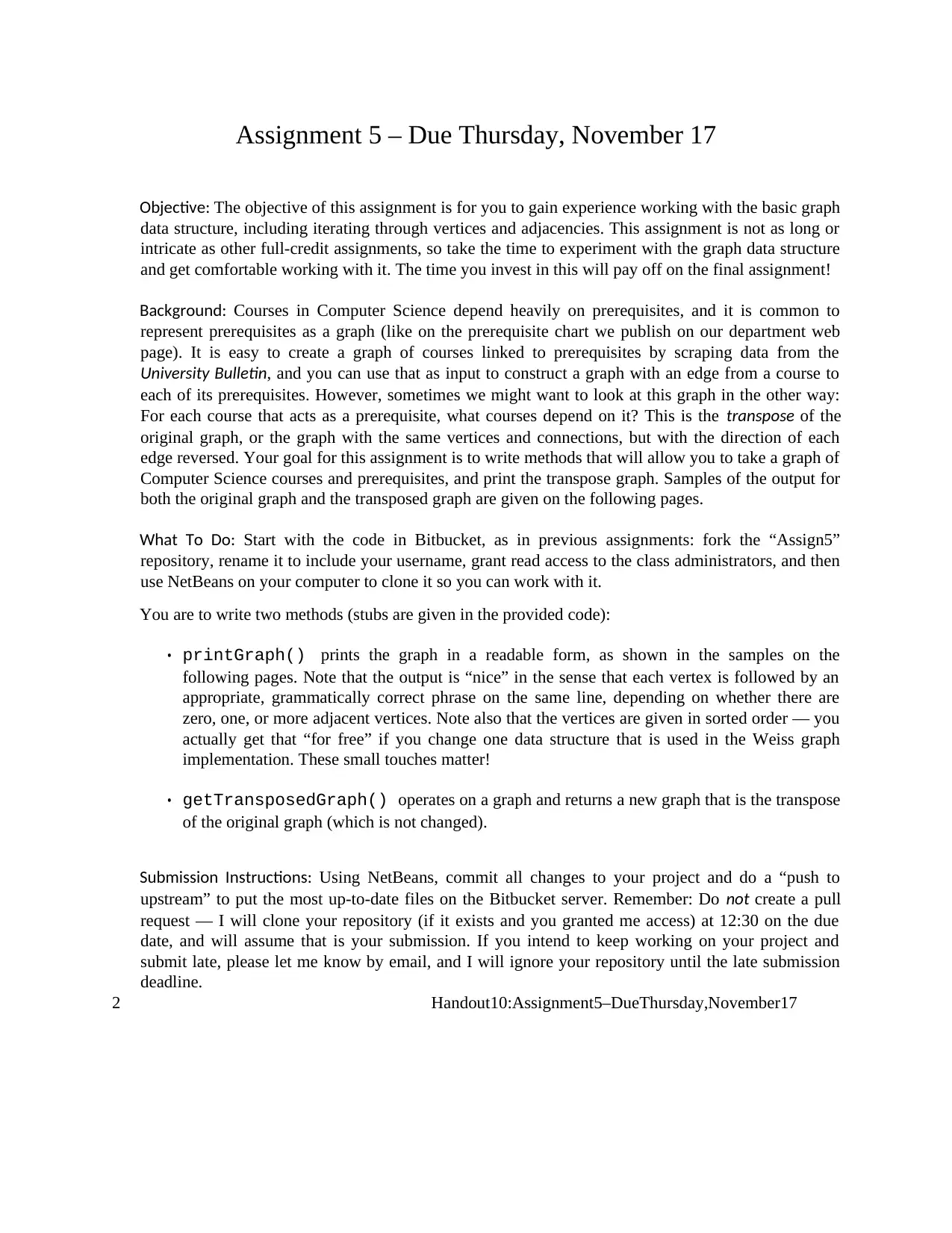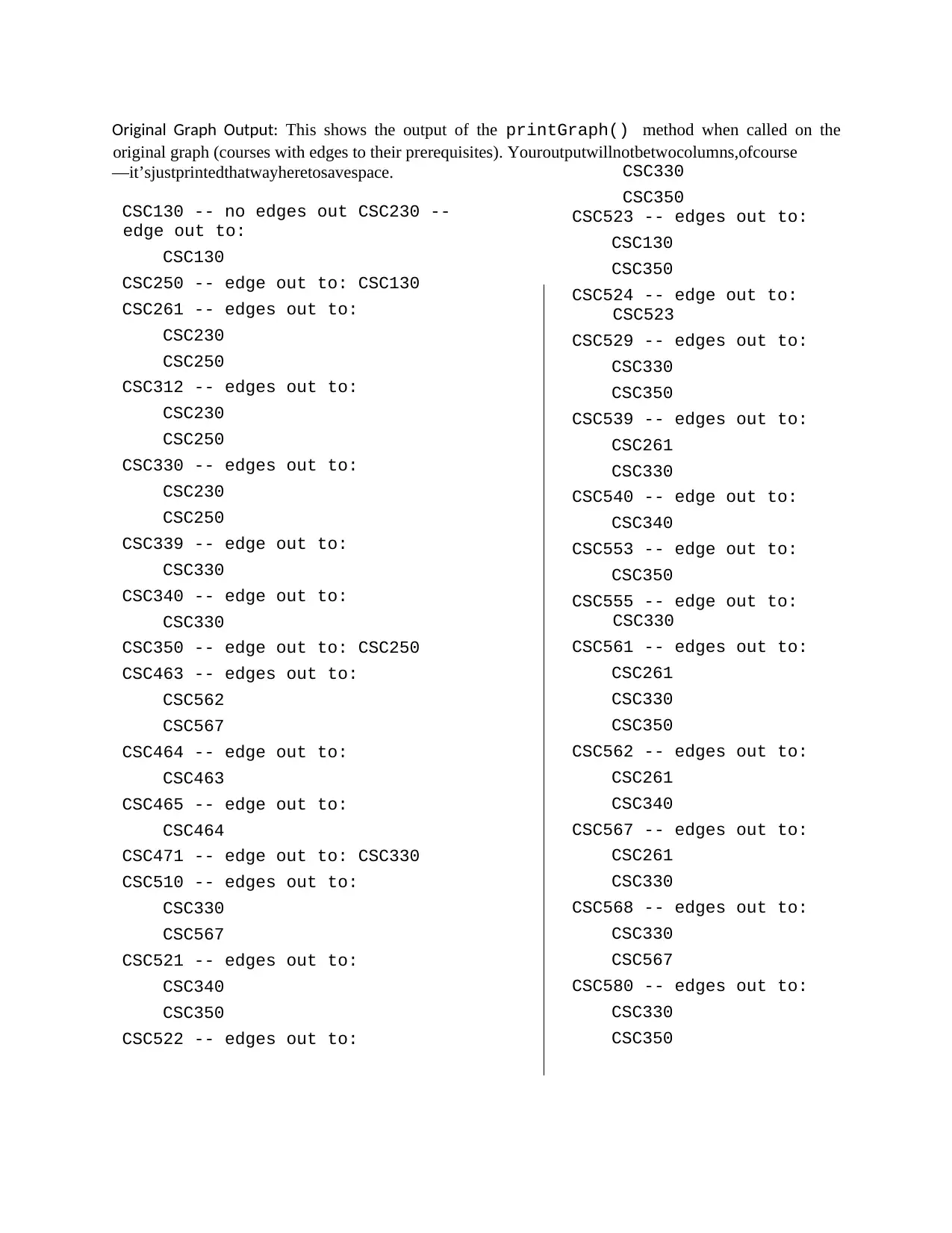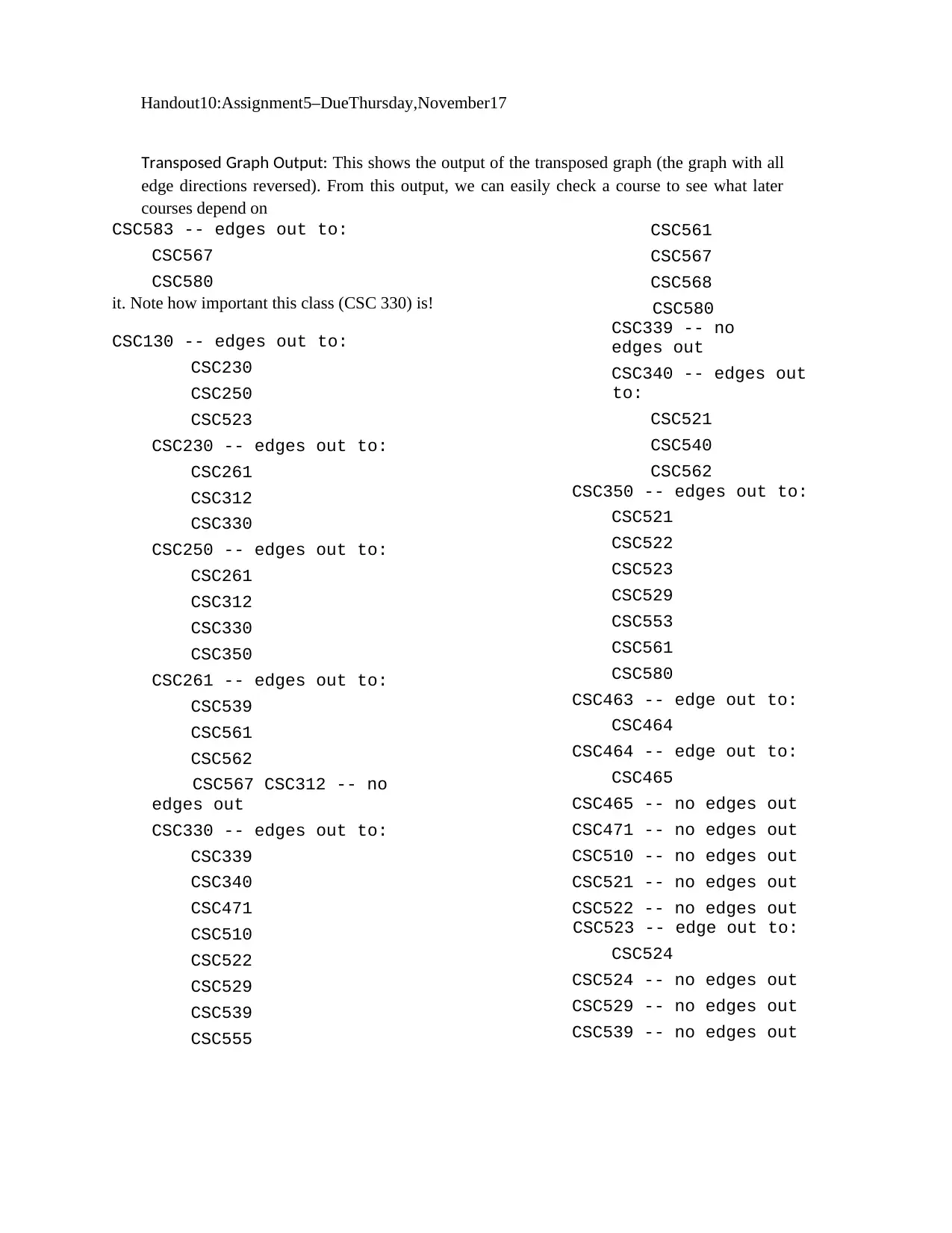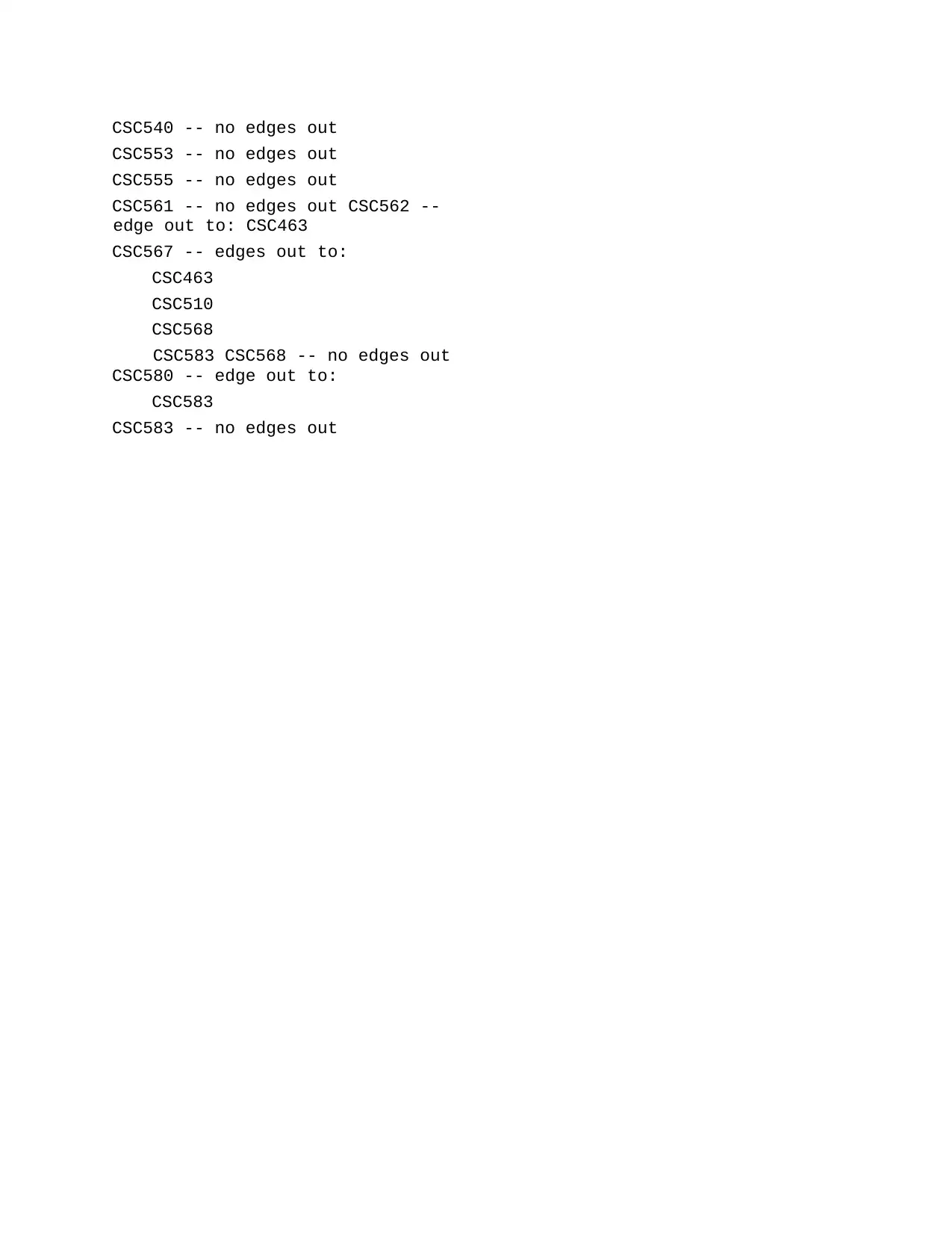Assignment 5: Graph Transpose
VerifiedAdded on 2019/10/09
|4
|1092
|99
Practical Assignment
AI Summary
This practical assignment challenges students to implement two methods: `printGraph()` and `getTransposedGraph()`. `printGraph()` formats a graph's representation for readability, while `getTransposedGraph()` creates a new graph representing the transpose of the input graph (reversing edge directions). The assignment uses a provided codebase in Bitbucket, requiring students to fork, clone, and modify the code. The assignment emphasizes working with graph data structures, iterating through vertices and adjacencies, and preparing students for a final assignment. Sample outputs for both the original and transposed graphs are provided. Submission involves committing changes to Bitbucket and avoiding pull requests.

Assignment 5 – Due Thursday, November 17
Objective: The objective of this assignment is for you to gain experience working with the basic graph
data structure, including iterating through vertices and adjacencies. This assignment is not as long or
intricate as other full-credit assignments, so take the time to experiment with the graph data structure
and get comfortable working with it. The time you invest in this will pay off on the final assignment!
Background: Courses in Computer Science depend heavily on prerequisites, and it is common to
represent prerequisites as a graph (like on the prerequisite chart we publish on our department web
page). It is easy to create a graph of courses linked to prerequisites by scraping data from the
University Bulletin, and you can use that as input to construct a graph with an edge from a course to
each of its prerequisites. However, sometimes we might want to look at this graph in the other way:
For each course that acts as a prerequisite, what courses depend on it? This is the transpose of the
original graph, or the graph with the same vertices and connections, but with the direction of each
edge reversed. Your goal for this assignment is to write methods that will allow you to take a graph of
Computer Science courses and prerequisites, and print the transpose graph. Samples of the output for
both the original graph and the transposed graph are given on the following pages.
What To Do: Start with the code in Bitbucket, as in previous assignments: fork the “Assign5”
repository, rename it to include your username, grant read access to the class administrators, and then
use NetBeans on your computer to clone it so you can work with it.
You are to write two methods (stubs are given in the provided code):
• printGraph() prints the graph in a readable form, as shown in the samples on the
following pages. Note that the output is “nice” in the sense that each vertex is followed by an
appropriate, grammatically correct phrase on the same line, depending on whether there are
zero, one, or more adjacent vertices. Note also that the vertices are given in sorted order — you
actually get that “for free” if you change one data structure that is used in the Weiss graph
implementation. These small touches matter!
• getTransposedGraph() operates on a graph and returns a new graph that is the transpose
of the original graph (which is not changed).
Submission Instructions: Using NetBeans, commit all changes to your project and do a “push to
upstream” to put the most up-to-date files on the Bitbucket server. Remember: Do not create a pull
request — I will clone your repository (if it exists and you granted me access) at 12:30 on the due
date, and will assume that is your submission. If you intend to keep working on your project and
submit late, please let me know by email, and I will ignore your repository until the late submission
deadline.
2 Handout10:Assignment5–DueThursday,November17
Objective: The objective of this assignment is for you to gain experience working with the basic graph
data structure, including iterating through vertices and adjacencies. This assignment is not as long or
intricate as other full-credit assignments, so take the time to experiment with the graph data structure
and get comfortable working with it. The time you invest in this will pay off on the final assignment!
Background: Courses in Computer Science depend heavily on prerequisites, and it is common to
represent prerequisites as a graph (like on the prerequisite chart we publish on our department web
page). It is easy to create a graph of courses linked to prerequisites by scraping data from the
University Bulletin, and you can use that as input to construct a graph with an edge from a course to
each of its prerequisites. However, sometimes we might want to look at this graph in the other way:
For each course that acts as a prerequisite, what courses depend on it? This is the transpose of the
original graph, or the graph with the same vertices and connections, but with the direction of each
edge reversed. Your goal for this assignment is to write methods that will allow you to take a graph of
Computer Science courses and prerequisites, and print the transpose graph. Samples of the output for
both the original graph and the transposed graph are given on the following pages.
What To Do: Start with the code in Bitbucket, as in previous assignments: fork the “Assign5”
repository, rename it to include your username, grant read access to the class administrators, and then
use NetBeans on your computer to clone it so you can work with it.
You are to write two methods (stubs are given in the provided code):
• printGraph() prints the graph in a readable form, as shown in the samples on the
following pages. Note that the output is “nice” in the sense that each vertex is followed by an
appropriate, grammatically correct phrase on the same line, depending on whether there are
zero, one, or more adjacent vertices. Note also that the vertices are given in sorted order — you
actually get that “for free” if you change one data structure that is used in the Weiss graph
implementation. These small touches matter!
• getTransposedGraph() operates on a graph and returns a new graph that is the transpose
of the original graph (which is not changed).
Submission Instructions: Using NetBeans, commit all changes to your project and do a “push to
upstream” to put the most up-to-date files on the Bitbucket server. Remember: Do not create a pull
request — I will clone your repository (if it exists and you granted me access) at 12:30 on the due
date, and will assume that is your submission. If you intend to keep working on your project and
submit late, please let me know by email, and I will ignore your repository until the late submission
deadline.
2 Handout10:Assignment5–DueThursday,November17
Paraphrase This Document
Need a fresh take? Get an instant paraphrase of this document with our AI Paraphraser

Original Graph Output: This shows the output of the printGraph() method when called on the
original graph (courses with edges to their prerequisites). Youroutputwillnotbetwocolumns,ofcourse
—it’sjustprintedthatwayheretosavespace.
CSC130 -- no edges out CSC230 --
edge out to:
CSC130
CSC250 -- edge out to: CSC130
CSC261 -- edges out to:
CSC230
CSC250
CSC312 -- edges out to:
CSC230
CSC250
CSC330 -- edges out to:
CSC230
CSC250
CSC339 -- edge out to:
CSC330
CSC340 -- edge out to:
CSC330
CSC350 -- edge out to: CSC250
CSC463 -- edges out to:
CSC562
CSC567
CSC464 -- edge out to:
CSC463
CSC465 -- edge out to:
CSC464
CSC471 -- edge out to: CSC330
CSC510 -- edges out to:
CSC330
CSC567
CSC521 -- edges out to:
CSC340
CSC350
CSC522 -- edges out to:
CSC330
CSC350
CSC523 -- edges out to:
CSC130
CSC350
CSC524 -- edge out to:
CSC523
CSC529 -- edges out to:
CSC330
CSC350
CSC539 -- edges out to:
CSC261
CSC330
CSC540 -- edge out to:
CSC340
CSC553 -- edge out to:
CSC350
CSC555 -- edge out to:
CSC330
CSC561 -- edges out to:
CSC261
CSC330
CSC350
CSC562 -- edges out to:
CSC261
CSC340
CSC567 -- edges out to:
CSC261
CSC330
CSC568 -- edges out to:
CSC330
CSC567
CSC580 -- edges out to:
CSC330
CSC350
original graph (courses with edges to their prerequisites). Youroutputwillnotbetwocolumns,ofcourse
—it’sjustprintedthatwayheretosavespace.
CSC130 -- no edges out CSC230 --
edge out to:
CSC130
CSC250 -- edge out to: CSC130
CSC261 -- edges out to:
CSC230
CSC250
CSC312 -- edges out to:
CSC230
CSC250
CSC330 -- edges out to:
CSC230
CSC250
CSC339 -- edge out to:
CSC330
CSC340 -- edge out to:
CSC330
CSC350 -- edge out to: CSC250
CSC463 -- edges out to:
CSC562
CSC567
CSC464 -- edge out to:
CSC463
CSC465 -- edge out to:
CSC464
CSC471 -- edge out to: CSC330
CSC510 -- edges out to:
CSC330
CSC567
CSC521 -- edges out to:
CSC340
CSC350
CSC522 -- edges out to:
CSC330
CSC350
CSC523 -- edges out to:
CSC130
CSC350
CSC524 -- edge out to:
CSC523
CSC529 -- edges out to:
CSC330
CSC350
CSC539 -- edges out to:
CSC261
CSC330
CSC540 -- edge out to:
CSC340
CSC553 -- edge out to:
CSC350
CSC555 -- edge out to:
CSC330
CSC561 -- edges out to:
CSC261
CSC330
CSC350
CSC562 -- edges out to:
CSC261
CSC340
CSC567 -- edges out to:
CSC261
CSC330
CSC568 -- edges out to:
CSC330
CSC567
CSC580 -- edges out to:
CSC330
CSC350

CSC583 -- edges out to:
CSC567
CSC580
it. Note how important this class (CSC 330) is!
CSC130 -- edges out to:
CSC230
CSC250
CSC523
CSC230 -- edges out to:
CSC261
CSC312
CSC330
CSC250 -- edges out to:
CSC261
CSC312
CSC330
CSC350
CSC261 -- edges out to:
CSC539
CSC561
CSC562
CSC567 CSC312 -- no
edges out
CSC330 -- edges out to:
CSC339
CSC340
CSC471
CSC510
CSC522
CSC529
CSC539
CSC555
CSC561
CSC567
CSC568
CSC580
CSC339 -- no
edges out
CSC340 -- edges out
to:
CSC521
CSC540
CSC562
CSC350 -- edges out to:
CSC521
CSC522
CSC523
CSC529
CSC553
CSC561
CSC580
CSC463 -- edge out to:
CSC464
CSC464 -- edge out to:
CSC465
CSC465 -- no edges out
CSC471 -- no edges out
CSC510 -- no edges out
CSC521 -- no edges out
CSC522 -- no edges out
CSC523 -- edge out to:
CSC524
CSC524 -- no edges out
CSC529 -- no edges out
CSC539 -- no edges out
Handout10:Assignment5–DueThursday,November17
Transposed Graph Output: This shows the output of the transposed graph (the graph with all
edge directions reversed). From this output, we can easily check a course to see what later
courses depend on
CSC567
CSC580
it. Note how important this class (CSC 330) is!
CSC130 -- edges out to:
CSC230
CSC250
CSC523
CSC230 -- edges out to:
CSC261
CSC312
CSC330
CSC250 -- edges out to:
CSC261
CSC312
CSC330
CSC350
CSC261 -- edges out to:
CSC539
CSC561
CSC562
CSC567 CSC312 -- no
edges out
CSC330 -- edges out to:
CSC339
CSC340
CSC471
CSC510
CSC522
CSC529
CSC539
CSC555
CSC561
CSC567
CSC568
CSC580
CSC339 -- no
edges out
CSC340 -- edges out
to:
CSC521
CSC540
CSC562
CSC350 -- edges out to:
CSC521
CSC522
CSC523
CSC529
CSC553
CSC561
CSC580
CSC463 -- edge out to:
CSC464
CSC464 -- edge out to:
CSC465
CSC465 -- no edges out
CSC471 -- no edges out
CSC510 -- no edges out
CSC521 -- no edges out
CSC522 -- no edges out
CSC523 -- edge out to:
CSC524
CSC524 -- no edges out
CSC529 -- no edges out
CSC539 -- no edges out
Handout10:Assignment5–DueThursday,November17
Transposed Graph Output: This shows the output of the transposed graph (the graph with all
edge directions reversed). From this output, we can easily check a course to see what later
courses depend on
⊘ This is a preview!⊘
Do you want full access?
Subscribe today to unlock all pages.

Trusted by 1+ million students worldwide

CSC540 -- no edges out
CSC553 -- no edges out
CSC555 -- no edges out
CSC561 -- no edges out CSC562 --
edge out to: CSC463
CSC567 -- edges out to:
CSC463
CSC510
CSC568
CSC583 CSC568 -- no edges out
CSC580 -- edge out to:
CSC583
CSC583 -- no edges out
CSC553 -- no edges out
CSC555 -- no edges out
CSC561 -- no edges out CSC562 --
edge out to: CSC463
CSC567 -- edges out to:
CSC463
CSC510
CSC568
CSC583 CSC568 -- no edges out
CSC580 -- edge out to:
CSC583
CSC583 -- no edges out
1 out of 4
Your All-in-One AI-Powered Toolkit for Academic Success.
+13062052269
info@desklib.com
Available 24*7 on WhatsApp / Email
![[object Object]](/_next/static/media/star-bottom.7253800d.svg)
Unlock your academic potential
Copyright © 2020–2025 A2Z Services. All Rights Reserved. Developed and managed by ZUCOL.

